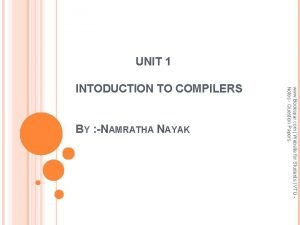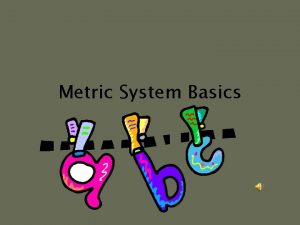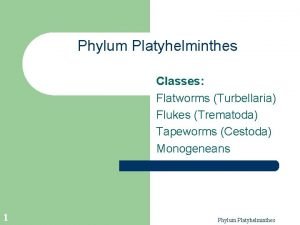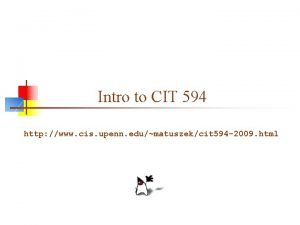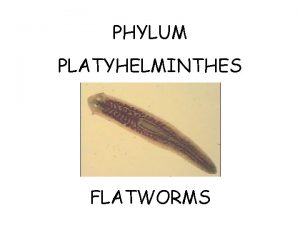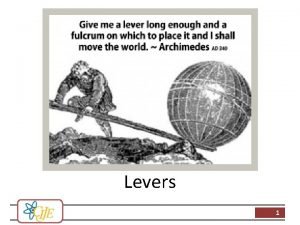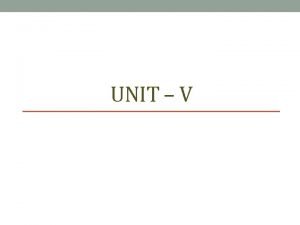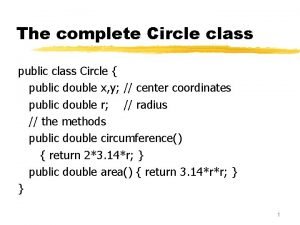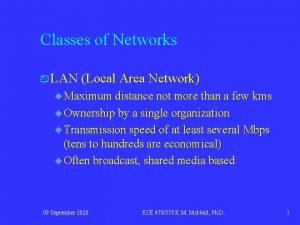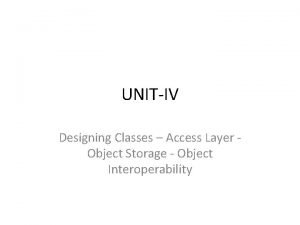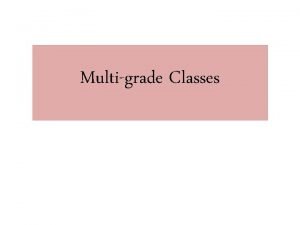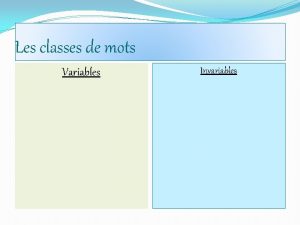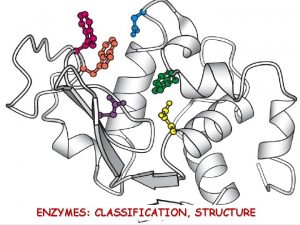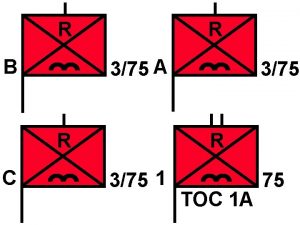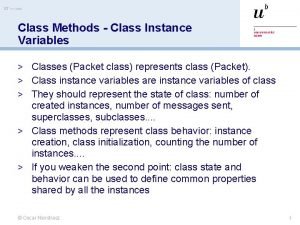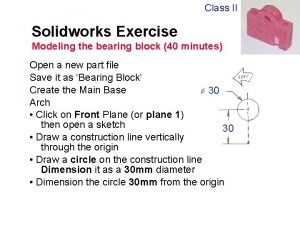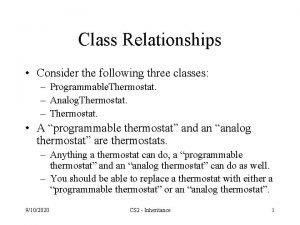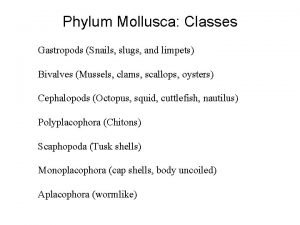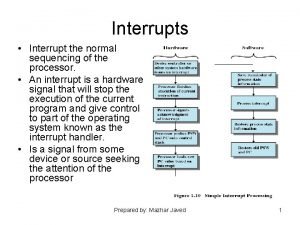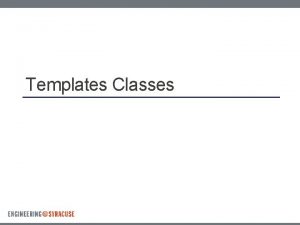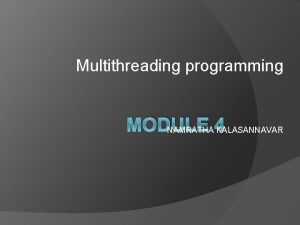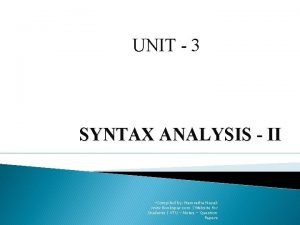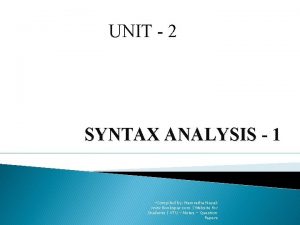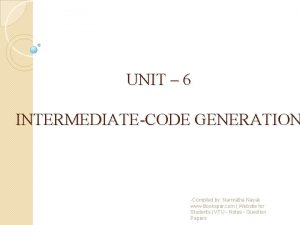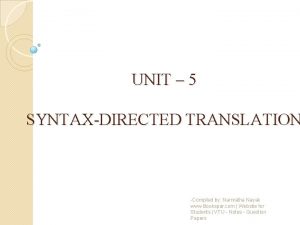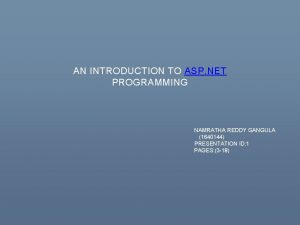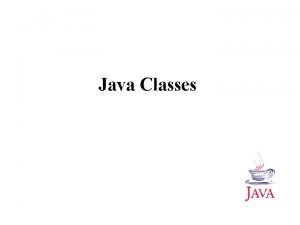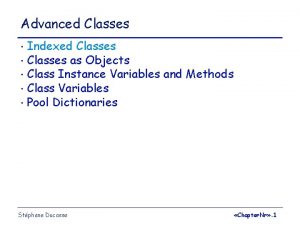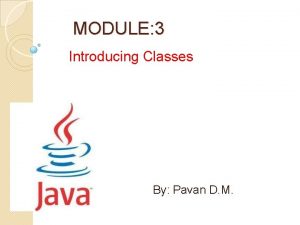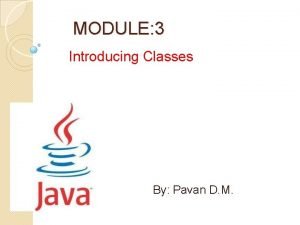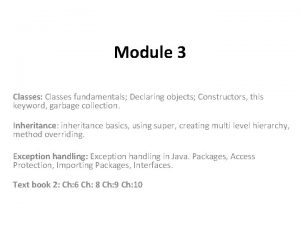MODULE 3 17 CS 42 Introducing Classes NAMRATHA


























































































































![Example class Exc 2 { public static void main(String args[ ]) { int d, Example class Exc 2 { public static void main(String args[ ]) { int d,](https://slidetodoc.com/presentation_image_h2/09d76bbe363efb46c2e6978544bdcb58/image-123.jpg)






















- Slides: 145

MODULE: 3 17 CS 42 Introducing Classes NAMRATHA KALASANNAVAR

INTRODUCTION • The class is at the core of Java. It is the logical construct upon which the entire Java language is built because it defines the shape and nature of an object. • As such, the class forms the basis for object-oriented programming in Java. Any concept you wish to implement in a Java program must be encapsulated within a class. • Class Fundamentals : Perhaps the most important thing to understand about a class is that it defines a new data type. • In Java main() is encapsulated by class. • Once defined, this new type can be used to create objects of that type. • Thus, a class is a template for an object, and an object is an instance of a class.

The General Form of a Class • When you define a class, you declare its exact form and nature. You do this by specifying the data that it contains and the code that operates on that data. While very simple classes may contain only code or only data, most real-world classes contain both. • A class is declared by use of the class keyword. The classes that have been used up to this point are actually very limited examples of its complete form. classname { type instance-variable 1; type instance-variable 2; //. . . type instance-variable. N; type methodname 1(parameter-list) { // body of method } type methodname 2(parameter-list) { // body of method } //. . . type methodname. N(parameter-list) { // body of method } }

Contd…. • The data, or variables, defined within a class are called instance variables. • The code is contained within methods. • Collectively, the methods and variables defined within a class are called members of the class. • In most classes, the instance variables are acted upon and accessed by the methods defined for that class. • Thus, as a general rule, it is the methods that determine how a class’ data can be used. • Variables defined within a class are called instance variables because each instance of the class (that is, each object of the class) contains its own copy of these variables. Thus, the data for one object is separate and unique from the data for another. • All methods have the same general form as main( ), which we have been using thus far. However, most methods will not be specified as static or public. • Notice that the general form of a class does not specify a main( ) method. Java classes do not need to have a main( ) method. You only specify one if that class is the starting point for your program.

Access Specifiers/ Modifiers

Contd… • Class Access Specifiers/Modifiers Public: If top level class within a package is declared as Public, then it is accessible both inside and outside of the package. Default: If no access modifier is specified in the declaration of the top level class, then • it is accessible only within package level. It is not accessible in other packages or sub packages.

Contd…

A Simple Class • Let’s begin our study of the class with a simple example. Here is a class called Box that defines three instance variables: width, height, and depth. class Box { double width; double height; double depth; }

Contd… • As stated, a class defines a new type of data. In this case, the new data type is called Box. • You will use this name to declare objects of type Box. It is important to remember that a class declaration only creates a template; it does not create an actual object. • Thus, the preceding code does not cause any objects of type Box to come into existence. • To actually create a Box object, you will use a statement like the following: Box mybox = new Box( ); // create a Box object called mybox • After this statement executes, mybox will be an instance of Box. Thus, it will have “physical” reality. • As mentioned earlier, each time you create an instance of a class, you are creating an object that contains its own copy of each instance variable defined by the class. • Thus, every Box object will contain its own copies of the instance variables width, height, and depth. • To access these variables, you will use the dot (. ) operator. • The dot operator links the name of the object with the name of an instance variable.

Contd… • For example, to assign the width variable of mybox the value 100, you would use the following statement: mybox. width = 100; • This statement tells the compiler to assign the copy of width that is contained within the mybox object the value of 100. • In general, you use the dot operator to access both the instance variables and the methods within an object. • LETS LOOK AT THE EXAMPLE • You should call the file that contains this program Box. Demo. java, because the main( ) method is in the class called Box. Demo, not the class called Box. • When you compile this program, you will find that two. class files have been created, one for Box and one for Box. Demo. • The Java compiler automatically puts each class into its own. class file. It is not necessary for both the Box and the Box. Demo class to actually be in the same source file. • You could put each class in its own file, called Box. java and Box. Demo. java, respectively.

Contd… • To run this program, you must execute Box. Demo. class. When you do, you will see the following output: Volume is 3000. 0 • As stated earlier, each object has its own copies of the instance variables. This means that if you have two Box objects, each has its own copy of depth, width, and height. • It is important to understand that changes to the instance variables of one object have no effect on the instance variables of another. • As you can see, mybox 1’s data is completely separate from the data contained in mybox 2

Declaring Objects • As just explained, when you create a class, you are creating a new data type. You can use this type to declare objects of that type. • However, obtaining objects of a class is a two-step process. - First, you must declare a variable of the class type. This variable does not define an object. Instead, it is simply a variable that can refer to an object. -- Second, you must acquire an actual, physical copy of the object and assign it to that variable. • You can do this using the new operator. • The new operator dynamically allocates (that is, allocates at run time) memory for an object and returns a reference to it. • This reference is then stored in the variable. Thus, in Java, all class objects must be dynamically allocated. • In the preceding sample programs, a line similar to the following is used to declare an object of type Box: • This statement combines the two steps just described. It can be rewritten like this to show each step more clearly: • Box mybox; // declare reference to object Box mybox = new Box( ); mybox = new Box(); // allocate a Box object

Contd…. • The first line declares mybox as a reference to an object of type Box. • After this line executes, mybox contains the value null, which indicates that it does not yet point to an actual object. • Any attempt to use mybox at this point will result in a compile-time error. • The next line allocates an actual object and assigns a reference to it to mybox. • After the second line executes, you can use mybox as if it were a Box object. • But in reality, mybox simply holds the memory address of the actual Box object. A Closer Look at new • As just explained, the new operator dynamically allocates memory for an object. It has this general form: class-var = new classname( );

Contd…. Here, class-var is a variable of the class type being created. The classname is the name of the class that is being instantiated. The class name followed by parentheses specifies the constructor for the class. A constructor defines what occurs when an object of a class is created. Constructor are an important part of all classes and have many significant attributes.

Contd… • Most real-world classes explicitly define their own constructors within their class definition. • However, if no explicit constructor is specified, then Java will automatically supply a default constructor. • This is the case with Box. For now, we will use the default constructor. • you might be wondering why you do not need to use new for such things as integers or characters. • The answer is that Java’s primitive types are not implemented as objects. Rather, they are implemented as “normal” variables. • Objects have many features and attributes that require Java to treat them differently than it treats the primitive types. • By not applying the same overhead to the primitive types that applies to objects, Java can implement the primitive types more efficiently. • It is important to understand that new allocates memory for an object during run time. • The advantage of this approach is that your program can create as many or as few objects as it needs during the execution of your program.

Contd… • However, since memory is finite, it is possible that new will not be able to allocate memory for an object because insufficient memory exists. If this happens, a runtime exception will occur. • Let’s once again review the distinction between a class and an object. A class creates a new data type that can be used to create objects. • That is, a class creates a logical framework that defines the relationship between its members. When you declare an object of a class, you are creating an instance of that class. • Thus, a class is a logical construct. An object has physical reality. (That is, an object occupies space in memory. ) It is important to keep this distinction clearly in mind.

Assigning Object Reference Variables • Object reference variables act differently than you might expect when an assignment takes place. Box b 1 = new Box(); Box b 2 = b 1; • You might think that b 2 is being assigned a reference to a copy of the object referred to by b 1 b 2 • That is, you might think that b 1 and b 2 refer to separate and distinct objects. However, this would be wrong. • Instead, after this fragment executes, b 1 and b 2 will both refer to the same object. • The assignment of b 1 to b 2 did not allocate any memory or copy any part of the original object. • It simply makes b 2 refer to the same object as does b 1. Thus, any changes made to the object through b 2 will affect the object to which b 1 is referring, since they are the same object.

Contd…. • Although b 1 and b 2 both refer to the same object, they are not linked in any other way. • For example, a subsequent assignment to b 1 will simply unhook b 1 from the original object without affecting the object or affecting b 2. Box b 1 = new Box(); Box b 2 = b 1; //. . . b 1 = null; • Here, b 1 has been set to null, but b 2 still points to the original object.

Introducing Methods • As mentioned at the beginning of this chapter, classes usually consist of two things: instance variables and methods. • The topic of methods is a large one because Java gives them so much power and flexibility. • There are some fundamentals that you need to learn now so that you can begin to add methods to your classes. This is the general form of a method: type name(parameter-list) { // body of method } • Here, type specifies the type of data returned by the method. This can be any valid type, including class types that you create. If the method does not return a value, its return type must be void. • The name of the method is specified by name. This can be any legal identifier other than those already used by other items within the current scope.

Contd…. • The parameter-list is a sequence of type and identifier pairs separated by commas. Parameters are essentially variables that receive the value of the arguments passed to the method when it is called. • Methods that have a return type other than void return a value to the calling routine using the following form of the return statement: return value; • Here, value is the value returned. • Adding a Method to the Box Class : Although it is perfectly fine to • • create a class that contains only data, it rarely happens. Most of the time, you will use methods to access the instance variables defined by the class. In fact, methods define the interface to most classes. This allows the class implementor to hide the specific layout of internal data structures behind cleaner method abstractions. In addition to defining methods that provide access to data, you can also define methods that are used internally by the class itself. Let’s begin by adding a method to the Box class.

Contd… • It may have occurred to you while looking at the preceding programs that the computation of a box’s volume was something that was best handled by the Box class rather than the Box. Demo class. • After all, since the volume of a box is dependent upon the size of the box, it makes sense to have the Box class compute it. • CONSIDER the FOLLOWING EXAMPLE • Look closely at the following two lines of code: mybox 1. volume(); mybox 2. volume(); The first line here invokes the volume( ) method on mybox 1. hat is, it calls volume( ) relative to the mybox 1 object, using the object’s name followed by the dot operator. Thus, the call to mybox 1. volume( ) displays the volume of the box defined by mybox 1. • The call to mybox 2. volume( ) displays the volume of the box defined by mybox 2. Each time volume( ) is invoked, it displays the volume for the specified box.

Contd… • When mybox 1. volume( ) is executed, the Java run-time system transfers control to the code defined inside volume( ). • After the statements inside volume( ) have executed, control is returned to the calling routine, and execution resumes with the line of code following the call. • There is something very important to notice inside the volume( ) method: the instance variables width, height, and depth are referred to directly, without preceding them with an object name or the dot operator. • When a method uses an instance variable that is defined by its class, it does so directly, without explicit reference to an object and without use of the dot operator. • A method can directly invoke all the instance variable of the class if the method is present in the same class. • This means that width, height, and depth inside volume( ) implicitly refer to the copies of those variables found in the object that invokes volume( ). • When an instance variable is accessed by code that is not part of the class in which that instance variable is defined? • It must be done through an object, by use of the dot operator. • However, when an instance variable is accessed by code that is part of the same class as the instance variable, that variable can be referred to directly.

Returning a Value • While the implementation of volume( ) does move the computation of a box’s volume inside the Box class where it belongs, it is not the best way to do it. • A better way to implement volume( ) is to have it compute the volume of the box and return the result to the caller. CONSIDER THE EXAMPLE • As you can see, when volume( ) is called, it is put on the right side of an assignment statement. On the left is a variable, in this case vol, that will receive the value returned by volume( ). Thus, after vol = mybox 1. volume(); executes, the value of mybox 1. volume( ) is 3, 000 and this value then is stored in vol. • There are two important things to understand about returning values: 1) The type of data returned by a method must be compatible with the return type specified by the method. For example, if the return type of some method is boolean, you could not return an integer. 2) The variable receiving the value returned by a method (such as vol, in this case) must also be compatible with the return type specified for the method.

Adding a Method That Takes Parameters • While some methods don’t need parameters, most do. Parameters allow a method to be generalized. That is, a parameterized method can operate on a variety of data and/or be used in a number of slightly different situations. • Method Without Parameter int square( ) { return 10 * 10; } Method With Parameter int square(int i) { return i * i; } While this method does, indeed, return the value of 10 squared, its use is very limited. However, if you modify the method so that it takes a parameter, as shown next, then you can make square( ) much more useful. Now, square( ) will return the square of whatever value it is called with. That is, square( ) isnow a general-purpose method that can compute the square of any integer value, rather than just 10.

Contd… • Here is an example: • • Argument int x, y; x = square(5); // x equals 25 x = square(9); // x equals 81 y = 2; x = square(y); // x equals 4 It is important to keep the two terms parameter and argument straight. A parameter is a variable defined by a method that receives a value when the method is called. For example, in square( ), i is a parameter. An argument is a value that is passed to a method when it is invoked. For example, square(100) passes 100 as an argument. You can use a parameterized method to improve the Box class. In the preceding examples, the dimensions of each box had to be set separately by use of a sequence of statements, such as: mybox 1. width = 10; mybox 1. height = 20; mybox 1. depth = 15;

Contd…. • While this code works, it is troubling for two reasons. First, it is clumsy and error prone. For example, it would be easy to forget to set a dimension. Second, in welldesigned Java programs, instance variables should be accessed only through methods defined by their class. • Thus, a better approach to setting the dimensions of a box is to create a method that takes the dimensions of a box in its parameters and sets each instance variable appropriately. EXAMPLE • As you can see, the set. Dim( ) method is used to set the dimensions of each box. For example, when mybox 1. set. Dim(10, 20, 15);

Constructors • It can be tedious to initialize all of the variables in a class each time an instance is created. • Even when you add convenience functions like set. Dim( ), it would be simpler and more concise to have all of the setup done at the time the object is first created. • Because the requirement for initialization is so common, Java allows objects to initialize themselves when they are created. This automatic initialization is performed through the use of a constructor. • A constructor initializes an object immediately upon creation. It has the same name as the class in which it resides and is syntactically similar to a method. • Once defined, the constructor is automatically called immediately after the object is created, before the new operator completes. • Constructors look a little strange because they have no return type, not even void. This is because the implicit return type of a class’ constructor is the class type itself. • You can rework the Box example so that the dimensions of a box are automatically initialized when an object is constructed.

Example • As you can see, both mybox 1 and mybox 2 were initialized by the Box( ) constructor when they were created. • Since the constructor gives all boxes the same dimensions, 10 by 10, both mybox 1 and mybox 2 will have the same volume. • The println( ) statement inside Box( ) is for the sake of illustration only. Most constructors will not display anything. They will simply initialize an object. • Before moving on, let’s reexamine the new operator. As you know, when you allocate an object, you use the following general form: class-var = new classname( ); • Now you can understand why the parentheses are needed after the class name. What is actually happening is that the constructor for the class is being called. Thus, in the line Box mybox 1 = new Box(); • new Box( ) is calling the Box( ) constructor. When you do not explicitly define a constructor for a class, then Java creates a default constructor for the class. • This is why the preceding line of code worked in earlier versions of Box that did not define a constructor. The default constructor automatically initializes all instance variables to zero.

Parameterized Constructors • While the Box( ) constructor in the preceding example does initialize a Box object, it is not very useful—all boxes have the same dimensions. • What is needed is a way to construct Box objects of various dimensions. The easy solution is to add parameters to the constructor. • EXAMPLE The this Keyword : Sometimes a method will need to refer to the object that invoked it. To allow this, Java defines the this keyword. • this can be used inside any method to refer to the current object. That is, this is always a reference to the object on which the method was invoked. • You can use this anywhere a reference to an object of the current class’ type is permitted. // A redundant use of this. Box(double w, double h, double d) { this. width = w; this. height = h; this. depth = d; }

Contd… • This version of Box( ) operates exactly like the earlier version. The use of this is redundant, but perfectly correct. • Inside Box( ), this will always refer to the invoking object. While it is redundant in this case, this is useful in other contexts, one of which is explained in the next section.

Instance Variable Hiding • It is illegal in Java to declare two local variables with the same name inside the same or enclosing scopes. • Interestingly, you can have local variables, including formal parameters to methods, which overlap with the names of the class’ instance variables. • However, when a local variable has the same name as an instance variable, the local variable hides the instance variable. • This is why width, height, and depth were not used as the names of the parameters to the Box( ) constructor inside the Box class. • If they had been, then width would have referred to the formal parameter, hiding the instance variable width. • While it is usually easier to simply use different names, there is another way around this situation. • Because this lets you refer directly to the object, you can use it to resolve any name space collisions that might occur between instance variables and local variables.

EXAMPLE • For example, here is another version of Box( ), which uses width, height, and depth for parameter names and then uses this to access the instance variables by the same name: // Use this to resolve name-space collisions. Box(double width, double height, double depth) { this. width = width; this. height = height; this. depth = depth; } • A word of caution: The use of this in such a context can sometimes be confusing, and some programmers are careful not to use local variables and formal parameter names that hide instance variables. • that it is a good convention to use the same names for clarity, and use this to overcome the instance variable hiding.

Garbage Collection • Since objects are dynamically allocated by using the new operator, you might be wondering how such objects are destroyed and their memory released for later reallocation. • In some languages, such as C++, dynamically allocated objects must be manually released by use of a delete operator. • Java takes a different approach; it handles deallocation for you automatically. The technique that accomplishes this is called garbage collection. • It works like this: when no references to an object exist, that object is assumed to be no longer needed, and the memory occupied by the object can be reclaimed. There is no explicit need to destroy objects as in C++. • Garbage collection only occurs sporadically (if at all) during the execution of your program. It will not occur simply because one or more objects exist that are no longer used.

The finalize( ) Method • Sometimes an object will need to perform some action when it is destroyed. Ex: if an object is holding some non-Java resource such as a file handle or character font, then you might want to make sure these resources are freed before an object is destroyed. To handle such situations, Java provides a mechanism called finalization. • By using finalization, you can define specific actions that will occur when an object is just about to be reclaimed by the garbage collector. • To add a finalizer to a class, you simply define the finalize( ) method. The Java run time calls that method whenever it is about to recycle an object of that class. • Inside the finalize( ) method, you will specify those actions that must be performed before an object is destroyed. • The garbage collector runs periodically, checking for objects that are no longer referenced by any running state or indirectly through other referenced objects. • The finalize( ) method has this general form: protected void finalize( ) { // finalization code here }

Contd… • Here, the keyword protected is a specifier that prevents access to finalize( ) by code defined outside its class. • It is important to understand that finalize( ) is only called just prior to garbage collection. It is not called when an object goes out-of-scope. • This means that you cannot know when—or even if—finalize( ) will be executed. Therefore, your program should provide other means of releasing system resources, etc. , used by the object.

A Stack Class • EXAMPLE

A Closer Look at Methods and Classes • Overloading Methods : In Java it is possible to define two or more • • • methods within the same class that share the same name, as long as their parameter declarations are different. When this is the case, the methods are said to be overloaded, and the process is referred to as method overloading. Method overloading is one of the ways that Java supports polymorphism. When an overloaded method is invoked, Java uses the type and/or number of arguments as its guide to determine which version of the overloaded method to actually call. Thus, overloaded methods must differ in the type and/or number of their parameters. While overloaded methods may have different return types, the return type alone is insufficient to distinguish two versions of a method. When Java encounters a call to an overloaded method, it simply executes the version of the method whose parameters match the arguments used in the call EXAMPLE.

Contd…. • As you can see, test( ) is overloaded four times. • The first version takes no parameters, • the second takes one integer parameter, the third takes two integer parameters, and the fourth takes one double parameter. • The fact that the fourth version of test( ) also returns a value is of no consequence relative to overloading, since return types do not play a role in overload resolution. • When an overloaded method is called, Java looks for a match between the arguments used to call the method and the method’s parameters. However, this match need not always be exact. • In some cases, Java’s automatic type conversions can play a role in overload resolution. • EXAMPLE As you can see in the example program does not define test(int). • Therefore, when test( ) is called with an integer argument inside Overload, no matching method is found. • However, Java can automatically convert an integer into a double, and this conversion can be used to resolve the call.

Contd… • Therefore, after test(int) is not found, Java elevates i to double and then calls test(double). • Of course, if test(int) had been defined, it would have been called instead. Java will employ its automatic type conversions only if no exact match is found. • Method overloading supports polymorphism because it is one way that Java implements the “one interface, multiple methods” paradigm. • In languages that do not support method overloading, each method must be given a unique name. However, frequently you will want to implement essentially the same method for different types of data. • Consider the absolute value function. • In languages that do not support overloading, there are usually three or more versions of this function, each with a slightly different name. • For instance, in C, the function abs( ) returns the absolute value of an integer, labs( ) returns the absolute value of a long integer, and fabs( ) returns the absolute value of a floating-point value. • Since C does not support overloading, each function has to have its own name, even though all three functions do essentially the same thing. This makes the situation more complex, conceptually, than it actually is.

Contd… • you still have three names to remember. • This situation does not occur in Java, because each absolute value method can use the same name. • Java’s standard class library includes an absolute value method, called abs( ). • This method is overloaded by Java’s Math class to handle all numeric types. Java determines which version of abs( ) to call based upon the type of argument. • The value of overloading is that ------it allows related methods to be accessed by use of a common name. • Thus, the name abs represents the general action that is being performed. It is left to the compiler to choose the right specific version for a particular circumstance. • You, the programmer, need only remember the general operation being performed. Through the application of polymorphism, several names have been reduced to one. • When you overload a method, each version of that method can perform any activity you desire. There is no rule stating that overloaded methods must relate to one another. • However, from a stylistic point of view, method overloading implies a relationship. Thus, while you can use the same name to overload unrelated methods, you should not.

Overloading Constructors • In addition to overloading normal methods, you can also overload constructor methods. In fact, for most real-world classes that you create, overloaded constructors will be the norm, not the exception. class Box { double width; double height; double depth; // This is the constructor for Box(double w, double h, double d) { width = w; height = h; depth = d; } // compute and return volume double volume() { return width * height * depth; } } As you can see, the Box( ) constructor requires three parameters. This means that all declarations of Box objects must pass three arguments to the Box( ) constructor. Box ob = new Box( ); // This is invalid here

Contd… • It leads to some important questions… • Can we find out initial dimensions of Box. . • What will the value when no dimension is specified for Box. • Can we find volume of Cube. . Etc… • To all the above questions we have solution : simply overload the Box constructor so that it handles the situations just described. EXAMPLE

Using Objects as Parameters • So far, we have only been using simple types as parameters to methods. However, it is both correct and common to pass objects to methods. For example, consider the following short program: // Objects may be passed to methods. class Test { int a, b; Test(int i, int j) { a = i; b = j; } // return true if o is equal to the invoking object boolean equals(Test o) { if(o. a == a && o. b == b) return true; else return false; } } class Pass. Ob { public static void main(String args[ ]) { Test ob 1 = new Test(100, 22); Test ob 2 = new Test(100, 22); Test ob 3 = new Test(-1, -1); System. out. println("ob 1 == ob 2: " + ob 1. equals(ob 2)); System. out. println("ob 1 == ob 3: " + ob 1. equals(ob 3)); } }

Contd… • As you can see, the equals( ) method inside Test compares two objects for equality and returns the result. That is, it compares the invoking object with the one that it is passed. • If they contain the same values, then the method returns true. Otherwise, it returns false. Notice that the parameter o in equals( ) specifies Test as its type. • One of the most common uses of object parameters involves constructors. Frequently, you will want to construct a new object so that it is initially the same as some existing object. To do this, you must define a constructor that takes an object of its class as a parameter. EXAMPLE

Inheritance • Inheritance is one of the cornerstones of object-oriented programming because it allows the creation of hierarchical classifications. • Using inheritance, you can create a general class that defines traits common to a set of related items. This class can then be inherited by other, more specific classes, each adding those things that are unique to it. • In the terminology of Java, a class that is inherited is called a superclass. • The class that does the inheriting is called a subclass. Therefore, a subclass is a specialized version of a superclass. It inherits all of the instance variables and methods defined by the superclass and adds its own elements. Inheritance Basics • To inherit a class, you simply incorporate the definition of one class into another by using the extends keyword. • The following program creates a superclass called A and a subclass called B. Notice how the keyword extends is used to create a subclass of A.

Example // A simple example of inheritance. // Create a superclass A { int i, j; void showij( ) { System. out. println("i and j: " + i + " " + j); } } // Create a subclass by extending class A. class B extends A { int k; void showk( ) { System. out. println("k: " + k); } void sum() { System. out. println("i+j+k: " + (i+j+k)); } } class Simple. Inheritance { public static void main(String args[]) { A super. Ob = new A(); B sub. Ob = new B(); // The superclass may be used by itself. super. Ob. i = 10; super. Ob. j = 20; System. out. println("Contents of super. Ob: "); super. Ob. showij(); System. out. println(); /* The subclass has access to all public members of its superclass. */ sub. Ob. i = 7; sub. Ob. j = 8; sub. Ob. k = 9; System. out. println("Contents of sub. Ob: "); sub. Ob. showij(); sub. Ob. showk(); System. out. println("Sum of i, j and k in sub. Ob: "); sub. Ob. sum(); } }

Contd…. • As you can see, the subclass B includes all of the members of its superclass, A. This is why sub. Ob can access i and j and call showij( ). Also, inside sum( ), i and j can be referred to directly, as if they were part of B. • Even though A is a superclass for B, it is also a completely independent, standalone class. Being a superclass for a subclass does not mean that the superclass cannot be used by itself. • The general form of a class declaration that inherits a superclass is shown here: class subclass-name extends superclass-name { // body of class } • Java does not support the inheritance of multiple superclasses into a single subclass.

Member Access and Inheritance • Although a subclass includes all of the members of its superclass, it cannot access those members of the superclass that have been declared as private. EXAMPLE // Create a superclass A { int i; // public by default private int j; // private to A void setij(int x, int y) { i = x; j = y; } } // A's j is not accessible here. class B extends A { int total; void sum() { total = i + j; // ERROR, j is not accessible here } } class Access { public static void main(String args[ ]) { B sub. Ob = new B(); sub. Ob. setij(10, 12); sub. Ob. sum(); System. out. println("Total is " +sub. Ob. total); } } A More Practical Example (BOX CLASS) • Here, the final version of the Box class developed in the preceding chapter will be extended to include a fourth component called weight.

Contd… • Box. Weight inherits all of the characteristics of Box and adds to them the weight component. • It is not necessary for Box. Weight to re-create all of the features found in Box. It can simply extend Box to meet its own purposes. • A major advantage of inheritance is that once you have created a superclass that defines the attributes common to a set of objects, it can be used to create any number of more specific subclasses. // Here, Box is extended to include color. class Color. Box extends Box { int color; // color of box Color. Box(double w, double h, double d, int c) { width = w; height = h; depth = d; color = c; } }

A Superclass Variable Can Reference a Subclass Object • A reference variable of a superclass can be assigned a reference to any subclass derived from that superclass Ref. Demo { public static void main(String args[ ]) { Box. Weight weightbox = new Box. Weight(3, 5, 7, 8. 37); Box plainbox = new Box( ); double vol; vol = weightbox. volume( ); System. out. println("Volume of weightbox is " + vol); System. out. println("Weight of weightbox is " +weightbox. weight); System. out. println ( ); // assign Box. Weight reference to Box reference plainbox = weightbox; vol = plainbox. volume( ); // OK, volume() defined in Box System. out. println("Volume of plainbox is " + vol); /* The following statement is invalid because plainbox does not define a weight member. */ // System. out. println("Weight of plainbox is " + plainbox. weight); } }

Contd… • Here, weightbox is a reference to Box. Weight objects, and plainbox is a reference to Box objects. • Since Box. Weight is a subclass of Box, it is permissible to assign plainbox a reference to the weightbox object. • It is important to understand that it is the type of the reference variable—not the type of the object that it refers to—that determines what members can be accessed. • That is, when a reference to a subclass object is assigned to a superclass reference variable, you will have access only to those parts of the object defined by the superclass. • This is why plainbox can’t access weight even when it refers to a Box. Weight object. If you think about it, this makes sense, because the superclass has no knowledge of what a subclass adds to it. • This is why the last line of code in the preceding fragment is commented out. It is not possible for a Box reference to access the weight field, because Box does not define one.

Using super • In the preceding examples, classes derived from Box were not implemented as efficiently or as robustly as they could have been. • For example, the constructor for Box. Weight explicitly initializes the width, height, and depth fields of Box( ). • Not only does this duplicate code found in its superclass, which is inefficient, but it implies that a subclass must be granted access to these members. • However, there will be times when you will want to create a superclass that keeps the details of its implementation to itself. • In this case, there would be no way for a subclass to directly access or initialize these variables on its own. • Since encapsulation is a primary attribute of OOP, it is not surprising that Javam provides a solution to this problem. • Whenever a subclass needs to refer to its immediate superclass, it can do so by use of the keyword super. • super has two general forms. 1) The first calls the superclass constructor. 2) Used to access a member of the superclass that has been hidden by a member of a subclass.

Using super to Call Superclass Constructors • A subclass can call a constructor defined by its superclass by use of the following form of super: super(arg-list); • Here, arg-list specifies any arguments needed by the constructor in the superclass. super( )must always be the first statement executed inside a subclass’ constructor. • To see how super( ) is used, consider this improved version of the Box. Weight( ) class: // Box. Weight now uses super to initialize its Box attributes. class Box. Weight extends Box { double weight; // weight of box // initialize width, height, and depth using super( ) Box. Weight(double w, double h, double d, double m) { super(w, h, d); // call superclass constructor weight = m; } }

Contd… • Here, Box. Weight( ) calls super( ) with the arguments w, h, and d. This causes the Box( ) constructor to be called, which initializes width, height, and depth using these values. • Box. Weight no longer initializes these values itself. It only needs to initialize the value unique to it: weight. This leaves Box free to make these values private if desired. • In the preceding example, super( ) was called with three arguments. • Since constructors can be overloaded, super( ) can be called using any form defined by the superclass. • The constructor executed will be the one that matches the arguments. EXAMPLE Pay special attention to this constructor in Box. Weight( ): // construct clone of an object Box. Weight(Box. Weight ob) { // pass object to constructor super(ob); weight = ob. weight; }

Contd… • Notice that super( ) is passed an object of type Box. Weight—not of type Box. This still invokes the constructor Box(Box ob). • As mentioned earlier, a superclass variable can be used to reference any object derived from that class. • Thus, we are able to pass a Box. Weight object to the Box constructor. Of course, Box only has knowledge of its own members. • Let’s review the key concepts behind super( ). When a subclass calls super( ), it is calling the constructor of its immediate superclass. • Thus, super( ) always refers to the superclass immediately above the calling class. This is true even in a multileveled hierarchy. A Second Use for super • The second form of super acts somewhat like this, except that it always refers to the superclass of the subclass in which it is used. This usage has the following general form: super. member

Contd… • Here, member can be either a method or an instance variable. • This second form of super is most applicable to situations in which member names of a subclass hide members by the same name in the superclass. // Using super to overcome name hiding. class A { int i; } // Create a subclass by extending class A. class B extends A { int i; // this i hides the i in A B(int a, int b) { super. i = a; // i in A i = b; // i in B } void show() { System. out. println("i in superclass: " + super. i); System. out. println("i in subclass: " + i); } } class Use. Super { public static void main(String args[ ]) { B sub. Ob = new B(1, 2); sub. Ob. show(); } }

Creating a Multilevel Hierarchy • Up to this point, we have been using simple class hierarchies that consist of only a superclass and a subclass. • However, you can build hierarchies that contain as many layers of inheritance as you like. As mentioned, it is perfectly acceptable to use a subclass as a superclass of another. • For example, given three classes called A, B, and C, C can be a subclass of B, which is a subclass of A. • When this type of situation occurs, each subclass inherits all of the traits found in all of its super classes. • In this case, C inherits all aspects of B and A. To see how a multilevel hierarchy can be useful, consider the following program. • In it, the subclass Box. Weight is used as a superclass to create the subclass called Shipment inherits all of the traits of Box. Weight and Box, and adds a field called cost, which holds the cost of shipping such a parcel. EXAMPLE • Because of inheritance, Shipment can make use of the previously defined classes of Box and Box. Weight, adding only the extra information it needs for its own, specific application. • This is part of the value of inheritance; it allows the reuse of code.

When Constructors Are Called • When a class hierarchy is created, in what order are the constructors for the classes that make up the hierarchy called? • For example, given a subclass called B and a superclass called A, is A’s constructor called before B’s, or vice versa? • The answer is that in a class hierarchy, constructors are called in order of derivation, from superclass to subclass. • Further, since super( ) must be the first statement executed in a subclass’ constructor, this order is the same whether or not super( ) is used. • If super( ) is not used, then the default or parameterless constructor of each superclass will be executed. EXAMPLE

Contd… • This example illustrates one other important point: super( ) always refers to the constructor in the closest superclass. • The super( ) in Shipment calls the constructor in Box. Weight. The super( ) in Box. Weight calls the constructor in Box. • In a class hierarchy, if a superclass constructor requires parameters, then all subclasses must pass those parameters “up the line. ” This is true whether or not a subclass needs parameters of its own.

Method Overriding • In a class hierarchy, when a method in a subclass has the same name and type signature as a method in its superclass, then the method in the subclass is said to override the method in the superclass. • When an overridden method is called from within a subclass, it will always refer to the version of that method defined by the subclass. // Method overriding. class A { int i, j; A(int a, int b) { i = a; j = b; } // display i and j void show() { System. out. println("i and j: " + i + " " + j); } } class B extends A { int k; B(int a, int b, int c) { super(a, b); k = c; } // display k – this overrides show() in A void show() { System. out. println("k: " + k); } } class Override { public static void main(String args[]) { B sub. Ob = new B(1, 2, 3); sub. Ob. show(); // this calls show() in B } }

Contd… • When show( ) is invoked on an object of type B, the version of show( ) defined within B is used. • That is, the version of show( ) inside B overrides the version declared in A. • If you wish to access the superclass version of an overridden method, you can do so by using super. • For example, in this version of B, the superclass version of show( ) is invoked within the subclass’ version. class B extends A { • int k; B(int a, int b, int c) { super(a, b); k = c; } void show( ) { super. show( ); // this calls A's show( ) System. out. println("k: " + k); } } If you substitute this version of A into the previous program, you will see the following output: i and j: 1 2 k: 3

Contd… • Method overriding occurs only when the names and the type signatures of the two methods are identical. If they are not, then the two methods are simply overloaded. // Methods with differing type signatures are overloaded – not overridden. class A { int i, j; A(int a, int b) { i = a; j = b; } // display i and j void show( ) { System. out. println("i and j: " + i + " " + j); } } // Create a subclass by extending class A. class B extends A { int k; B(int a, int b, int c) { super(a, b); k = c; } // overload show( ) void show(String msg) { System. out. println(msg + k); } } class Override { public static void main(String args[ ]) { B sub. Ob = new B(1, 2, 3); sub. Ob. show("This is k: "); // this calls show() in B sub. Ob. show(); // this calls show() in A } }

Contd… • The version of show( ) in B takes a string parameter. This makes its type signature different from the one in A, which takes no parameters. • Therefore, no overriding (or name hiding) takes place. Instead, the version of show( ) in B simply overloads the version of show( ) in A.

Dynamic Method Dispatch • While the examples in the preceding section demonstrate the mechanics of method overriding, they do not show its power. • Indeed, if there were nothing more to method overriding than a name space convention, then it would be, at best, an interesting curiosity, but of little real value. However, this is not the case. • Method overriding forms the basis for one of Java’s most powerful concepts: dynamic method dispatch. • Dynamic method dispatch is the mechanism by which a call to an overridden method is resolved at run time, rather than compile time. • Dynamic method dispatch is important because this is how Java implements run-time polymorphism. • Let’s begin by restating an important principle: a superclass reference variable can refer to a subclass object. • Java uses this fact to resolve calls to overridden methods at run time. BUT How. Here is the answer. • When an overridden method is called through a superclass reference, Java determines which version of that method to execute based upon the type of the object being referred to at the time the call occurs.

Contd… • Thus, this determination is made at run time. When different types of objects are referred to, different versions of an overridden method will be called. • In other words, it is the type of the object being referred to (not the type of the reference variable) that determines which version of an overridden method will be executed. • Therefore, if a superclass contains a method that is overridden by a subclass, then when different types of objects are referred to through a superclass reference variable, different versions of the method are executed. EXAMPLE • This program creates one superclass called A and two subclasses of it, called B and C. Subclasses B and C override callme( ) declared in A. • Inside the main( ) method, objects of type A, B, and C are declared. Also, a reference of type A, called r, is declared. • The program then in turn assigns a reference to each type of object to r and uses that reference to invoke callme( ). • As the output shows, the version of callme( ) executed is determined by the type of object being referred to at the time of the call.

Why Overridden Methods? • As stated earlier, overridden methods allow Java to support run-time polymorphism. • Polymorphism is essential to object-oriented programming for one reason: it allows a general class to specify methods that will be common to all of its derivatives, while allowing subclasses to define the specific implementation of some or all of those methods. • Overridden methods are another way that Java implements the “one interface, multiple methods” aspect of polymorphism. • Part of the key to successfully applying polymorphism is understanding that the superclasses and subclasses form a hierarchy which moves from lesser to greater specialization. • Used correctly, the superclass provides all elements that a subclass can use directly. It also defines those methods that the derived class must implement on its own. • This allows the subclass the flexibility to define its own methods, yet still enforces a consistent interface. • Thus, by combining inheritance with overridden methods, a superclass can define the general form of the methods that will be used by all of its subclasses. • Dynamic, run-time polymorphism is one of the most powerful mechanisms that objectoriented design brings to bear on code reuse and robustness.

Applying Method Overriding • Let’s look at a more practical example that uses method overriding. The following program creates a superclass called Figure that stores the dimensions of a twodimensional object. • It also defines a method called area( ) that computes the area of an object. The program derives two subclasses from Figure. • The first is Rectangle and the second is Triangle. Each of these subclasses overrides area( ) so that it returns the area of a rectangle and a triangle, respectively. • EXAMPLE

Using Abstract Classes • There are situations in which you will want to define a superclass that declares the structure of a given abstraction without providing a complete implementation of every method. • That is, sometimes you will want to create a superclass that only defines a generalized form that will be shared by all of its subclasses, leaving it to each subclass to fill in the details. • Such a class determines the nature of the methods that the subclasses must implement. • One way this situation can occur is when a superclass is unable to create a meaningful implementation for a method. • This is the case with the class Figure used in the preceding example. The definition of area( ) is simply a placeholder. • It will not compute and display the area of any type of object. • As you will see as you create your own class libraries, it is not uncommon for a method to have no meaningful definition in the context of its superclass. • You can handle this situation two ways. • One way, as shown in the previous example, is to simply have it report a warning message.

Contd…. • While this approach can be useful in certain situations—such as debugging—it is not usually appropriate. • You may have methods that must be overridden by the subclass in order for the subclass to have any meaning. • Consider the class Triangle. It has no meaning if area( ) is not defined. • In this case, you want some way to ensure that a subclass does, indeed, override all necessary methods. Java’s solution to this problem is the abstract method. • You can require that certain methods be overridden by subclasses by specifying the abstract type modifier. • These methods are sometimes referred to as subclasser responsibility because they have no implementation specified in the superclass. • Thus, a subclass must override them—it cannot simply use the version defined in the superclass. abstract type name(parameter-list); As you can see, no method body is present. • Any class that contains one or more abstract methods must also be declared abstract. • To declare a class abstract, you simply use the abstract keyword in front of the class keyword at the beginning of the class declaration.

Contd… • There can be no objects of an abstract class. That is, an abstract class cannot be directly instantiated with the new operator. • Such objects would be useless, because an abstract class is not fully defined. • Also, you cannot declare abstract constructors, or abstract static methods. • Any subclass of an abstract class must either implement all of the abstract methods in the superclass, or be itself declared abstract. • Here is a simple example of a class with an abstract method, followed by a class which implements that method: • Notice that no objects of class A are declared in the program. As mentioned, it is not possible to instantiate an abstract class. • One other point: class A implements a concrete method called callmetoo( ). This is perfectly acceptable. • Abstract classes can include as much implementation as they see fit. • Although abstract classes cannot be used to instantiate objects, they can be used to create object references, because Java’s approach to run-time polymorphism is implemented through the use of super class references. • Thus, it must be possible to create a reference to an abstract class so that it can be used to point to a subclass object.

Contd… • Using an abstract class, you can improve the Figure class shown earlier. Since there is no meaningful concept of area for an undefined two-dimensional figure, the following version of the program declares area( ) as abstract inside Figure. EXAMPLE • Although it is not possible to create an object of type Figure, you can create a reference variable of type Figure. The variable figref is declared as a reference to Figure, which means that it can be used to refer to an object of any class derived from Figure.

Using final with Inheritance • The keyword final has three uses. • First, it can be used to create the equivalent of a named constant. This use was described in the preceding chapter. • The other two uses of final apply to inheritance. Both are examined here. 1) Using final to Prevent Overriding 2) Using final to Prevent Inheritance • While method overriding is one of Java’s most powerful features, there will be times when you will want to prevent it from occurring. • To disallow a method from being overridden, specify final as a modifier at the start of its declaration. • Methods declared as final cannot be overridden class A { final void meth( ) { System. out. println("This is a final method. "); } } class B extends A { void meth( ) { // ERROR! Can't override. System. out. println("Illegal!"); } }

Contd… • Because meth( ) is declared as final, it cannot be overridden in B. If you attempt to do so, a compile-time error will result. • Using final to Prevent Inheritance : - Sometimes you will want to prevent a class from being inherited. To do this, precede the class declaration with final. Declaring a class as final implicitly declares all of its methods as final, too. • As you might expect, it is illegal to declare a class as both abstract and final since an abstract class is incomplete by itself and relies upon its subclasses to provide complete implementations. • Here is an example of a final class: final class A { //. . . } // The following class is illegal. class B extends A { // ERROR! Can't subclass A //. . . } As the comments imply, it is illegal for B to inherit A since A is declared as final.

The Object Class • There is one special class, Object, defined by Java. • All other classes are subclasses of Object. That is, Object is a superclass of all other classes. • This means that a reference variable of type Object can refer to an object of any other class. • Object defines the following methods, which means that they are available in every object.

Packages and Interfaces • Packages: - A package can be defined as grouping of related types (classes, interfaces, methods, etc ) providing access protection and namespace management. • Packages in Java are used to prevent naming conflicts, to control access, visibility control mechanism, etc. • Ex : Existing packages in Java : • java. lang -- consists of fundamental classes. java. io -- consists of I/O classes. Etc. • Package in Java is nothing but a folder in directory structure. • Java Packages are stored in hierarchical manner

Defining a Package • To create a package is quite easy: simply include a package command as the first statement in a Java source file. • Any classes declared within that file will belong to the specified package. • The package statement defines a name space in which classes are stored. If you omit the package statement, the class names are put into the default package, which has no name. • While the default package is fine for short, sample programs, it is inadequate for real applications. • This is the general form of the package statement: package pkg; • Here, pkg is the name of the package. For example, the following statement creates a package called My. Package. package My. Package; • Java uses file system directories to store packages. For example, the. class files for any classes you declare to be part of My. Package must be stored in a directory called My. Package. • Remember that case is significant, and the directory name must match the package name exactly.

Contd… • More than one file can include the same package statement. The package statement simply specifies to which package the classes defined in a file belong. • It does not exclude other classes in other files from being part of that same package. Most real-world packages are spread across many files. • You can create a hierarchy of packages. To do so, simply separate each package name from the one above it by use of a period. General Form package pkg 1[. pkg 2[. pkg 3]]; • A package hierarchy must be reflected in the file system of your Java development system. • For example, a package declared as package java. awt. image; • needs to be stored in javaawtimage in a Windows environment. • Be sure to choose your package names carefully. You cannot rename a package without renaming the directory in which the classes are stored.

Finding Packages and CLASSPATH • As just explained, packages are mirrored by directories. This raises an important question: • How does the Java run-time system know where to look for packages that you create? • The answer has three parts. • First, by default, the Java run-time system uses the current working directory as its starting point. • Thus, if your package is in a subdirectory of the current directory, it will be found. • Second, you can specify a directory path or paths by setting the CLASSPATH environmental variable. • Third, you can use the -classpath option with java and javac to specify the path to your classes. • For example, consider the following package specification: package My. Pack In order for a program to find My. Pack, one of three things must be true. • Either the program can be executed from a directory immediately above My. Pack, or the CLASSPATH must be set to include the path to My. Pack, or the -classpath option must specify the path to My. Pack when the program is run via java

Contd…. • When the second two options are used, the class path must not include My. Pack, itself. It must simply specify the path to My. Pack. • For example, in a Windows environment, if the path to My. Pack is C: My. ProgramsJavaMy. Pack • Then the class path to My. Pack is C: My. ProgramsJava • The easiest way to try the examples shown in this book is to simply create the package directories below your current development directory, put the. class files into the appropriate directories, and then execute the programs from the development directory.

A Short Package Example // A simple package My. Pack; class Balance { String name; double bal; Balance(String n, double b) { name = n; bal = b; } void show( ) { if(bal<0) System. out. print("--> "); System. out. println(name + ": $" + bal); } } class Account. Balance { public static void main(String args[ ]) { Balance current[ ] = new Balance[3]; current[0] = new Balance("K. J. Fielding", 123. 23); current[1] = new Balance("Will Tell", 157. 02); current[2] = new Balance("Tom Jackson", 12. 33); for(int i=0; i<3; i++) current[i]. show( ); } }

Contd… • Call this file Account. Balance. java and put it in a directory called My. Pack. • Next, compile the file. Make sure that the resulting. class file is also in the My. Pack directory. • Then, try executing the Account. Balance class, using the following command line: java My. Pack. Account. Balance Remember, you will need to be in the directory above My. Pack when you execute this command. • As explained, Account. Balance is now part of the package My. Pack. This means that it cannot be executed by itself. That is, you cannot use this command line: java Account. Balance • Account. Balance must be qualified with its package name.

Access Protection • In the preceding chapters, you learned about various aspects of Java’s access control mechanism and its access specifiers. • For example, you already know that access to a private member of a class is granted only to other members of that class. • Packages add another dimension to access control. As you will see, Java provides many levels of protection to allow fine-grained control over the visibility of variables and methods within classes, subclasses, and packages. • Classes and packages are both means of encapsulating and containing the name space and scope of variables and methods. • Packages act as containers for classes and other subordinate packages. Classes act as containers for data and code. • The class is Java’s smallest unit of abstraction. • Because of the interplay between classes and packages, Java addresses four categories of visibility for class members: 1) Subclasses in the same package 2) Non-subclasses in the same package 3) Subclasses in different packages 4) Classes that are neither in the same package nor subclasses

Contd… • The three access specifiers, private, public, and protected, provide a variety of ways to produce the many levels of access required by these categories. • While Java’s access control mechanism may seem complicated, we can simplify it as follows. Anything declared public can be accessed from anywhere. Anything declared private cannot be seen outside of its class.

Contd… • When a member does not have an explicit access specification, it is visible to subclasses as well as to other classes in the same package. • This is the default access. If you want to allow an element to be seen outside your current package, but only to classes that subclass your class directly, then declare that element protected. • A non-nested class has only two possible access levels: default and public. • When a class is declared as public, it is accessible by any other code. • If a class has default access, then it can only be accessed by other code within its same package. • When a class is public, it must be the only public class declared in the file, and the file must have the same name as the class.

An Access Example • The following example shows all combinations of the access control modifiers. This example has two packages and five classes. • Remember that the classes for the two different packages need to be stored in directories named after their respective packages—in this case, p 1 and p 2. • The source for the first package defines three classes: Protection, Derived, and Same. Package. • The first class defines four int variables in each of the legal protection modes. • The second class, Derived, is a subclass of Protection in the same package, p 1. • The third class, Same. Package, is not a subclass of Protection, but is in the same package and also has a ccess to all but n_pri.

Example This is file Protection. java: This is file Derived. java: package p 1; public class Protection { int n = 1; private int n_pri = 2; protected int n_pro = 3; public int n_pub = 4; public Protection() { System. out. println("base constructor"); System. out. println("n = " + n); System. out. println("n_pri = " + n_pri); System. out. println("n_pro = " + n_pro); System. out. println("n_pub = " + n_pub); } } package p 1; class Derived extends Protection { Derived( ) { System. out. println("derived constructor"); System. out. println("n = " + n); // class only // System. out. println("n_pri = "4 + n_pri); System. out. println("n_pro = " + n_pro); System. out. println("n_pub = " + n_pub); } }

Contd… This is file Same. Package. java: package p 2; package p 1; class Same. Package { Same. Package() { Protection p = new Protection( ); System. out. println("same package constructor"); System. out. println("n = " + p. n); // class only // System. out. println("n_pri = " + p. n_pri); System. out. println("n_pro = " + p. n_pro); System. out. println("n_pub = " + p. n_pub); } } class Protection 2 extends p 1. Protection { Protection 2() { System. out. println("derived other package constructor"); // class or package only // System. out. println("n = " + n); // class only // System. out. println("n_pri = " + n_pri); System. out. println("n_pro = " + n_pro); System. out. println("n_pub = " + n_pub); } }

Contd… This is file Other. Package. java: package p 2; class Other. Package { Other. Package( ) { p 1. Protection p = new p 1. Protection(); System. out. println("other package constructor"); // class or package only // System. out. println("n = " + p. n); // class only // System. out. println("n_pri = " + p. n_pri); // class, subclass or package only // System. out. println("n_pro = " + p. n_pro); System. out. println("n_pub = " + p. n_pub); } } // Demo package p 1; // Instantiate the various classes in p 1. public class Demo { public static void main(String args[]) { Protection ob 1 = new Protection(); Derived ob 2 = new Derived(); Same. Package ob 3 = new Same. Package(); } } // Demo package p 2; // Instantiate the various classes in p 2. public class Demo { public static void main(String args[]) { Protection 2 ob 1 = new Protection 2(); Other. Package ob 2 = new Other. Package(); } }

Importing Packages

Contd…

Contd….

Contd…

Interfaces Using the keyword interface, you can fully abstract a class’ interface from its implementation. That is, using interface, you can specify what a class must do, but not how it does it. Interface are syntactically similar to classes, but they lack instance variables, and their methods are declared without any body. This means that you can define interfaces that don’t make assumptions about how they are implemented. Once it is defined, any number of classes can implement an interface. “one interface, multiple methods” So it points to polymorphism feature of java.

Defining an Interface • Interfaces are designed to support dynamic method resolution at run time. When no access specifier is included, then default access results, and the interface is only available to other members of the package in which it is declared.

Contd… • When it is declared as public, the interface can be used by any other code. • In this case, the interface must be the only public interface declared in the file, and the file must have the same name as the interface. • name is the name of the interface, and can be any valid identifier. Notice that the methods that are declared have no bodies. • Variables can be declared inside of interface declarations. They are implicitly final and static, meaning they cannot be changed by the implementing class. They must also be initialized. All methods and variables are implicitly public. • Ex: It declares a simple interface that contains one method called callback( ) that takes a single integer • interface Callback { void callback(int param); }

Contd…

Contd…

Contd…

Implementing Interfaces • Once an interface has been defined, one or more classes can implement that interface. • To implement an interface, include the implements clause in a class definition, and then create the methods defined by the interface. • The general form of a class that includes the implements clause looks like this: classname [extends superclass] [implements interface [, interface. . . ]] { // class-body } • If a class implements more than one interface, the interfaces are separated with a comma. If a class implements two interfaces that declare the same method, then the same method will be used by clients of either interface. • The methods that implement an interface must be declared public. Also, the type signature of the implementing method must match exactly the type signature specified in the interface definition.

Example class Client implements Callback { // Implement Callback's interface public void callback(int p) { System. out. println("callback called with " + p); } • } • Notice that callback( ) is declared using the public access specifier. • It is both permissible and common for classes that implement interfaces to define additional members of their own. • For example, the following version of Client implements callback( ) and adds the method non. Iface. Meth( ):

Example class Client implements Callback { // Implement Callback's interface public void callback(int p) { System. out. println("callback called with " + p); } void non. Iface. Meth( ) { System. out. println("Classes that implement interfaces " + "may also define other members, too. "); } }

Accessing Implementations Through Interface References • You can declare variables as object references that use an interface rather than a class type. • Any instance of any class that implements the declared interface can be referred to by such a variable. • When you call a method through one of these references, the correct version will be called based on the actual instance of the interface being referred to. • This is one of the key features of interfaces. The method to be executed is looked up dynamically at run time, allowing classes to be created later than the code which calls methods on them. • The following example calls the callback( ) method via an interface reference variable: class Test. Iface { public static void main(String args[ ]) { Callback c = new Client(); The output of this program is shown c. callback(42); } } here: callback called with 42

Contd… • Notice that variable c is declared to be of the interface type Callback, yet it was assigned an instance of Client. • Although c can be used to access the callback( ) method, it cannot access any other members of the Client class. • An interface reference variable only has knowledge of the methods declared by its interface declaration. • Thus, c could not be used to access non. Iface. Meth( ) since it is defined by Client but not Callback. • While the preceding example shows, mechanically, how an interface reference variable can access an implementation object, it does not demonstrate the polymorphic power of such a reference.

Example // Another implementation of Callback. class Another. Client implements Callback { // Implement Callback's interface public void callback(int p) { System. out. println("Another version of callback"); System. out. println("p squared is " + (p*p)); } } class Test. Iface 2 { public static void main(String args[ ]) { Callback c = new Client( ); Another. Client ob = new Another. Client( ); c. callback(42); c = ob; // c now refers to Another. Client object c. callback(42); } } callback called with 42 Another version of callback p squared is 1764

Partial Implementations • If a class includes an interface but does not fully implement the methods defined by that interface, then that class must be declared as abstract class Incomplete implements Callback { int a, b; void show( ) { System. out. println(a + " " + b); } //. . . } • Here, the class Incomplete does not implement callback( ) and must be declared as abstract. Any class that inherits Incomplete must implement callback( ) or be declared abstract itself.

Nested Interfaces • An interface can be declared a member of a class or another interface. Such an interface is called a member interface or a nested interface. • A nested interface can be declared as public, private, or protected. This differs from a top-level interface, which must either be declared as public or use the default access level, as previously described. • When a nested interface is used outside of its enclosing scope, it must be qualified by the name of the class or interface of which it is a member. • Thus, outside of the class or interface in which a nested interface is declared, its name must be fully qualified. // A nested interface example. // This class contains a member interface. class A { // this is a nested interface public interface Nested. IF { boolean is. Not. Negative(int x); } } // B implements the nested interface. class B implements A. Nested. IF { public boolean is. Not. Negative(int x) { return x < 0 ? false : true; } } class Nested. IFDemo { public static void main(String args[ ]) { // use a nested interface reference A. Nested. IF nif = new B( ); if(nif. is. Not. Negative(10)) System. out. println("10 is not negative"); if(nif. is. Not. Negative(-12)) System. out. println("this won't be displayed"); } }

Contd… • Notice that A defines a member interface called Nested. IF and that it is declared public. Next, B implements the nested interface by specifying implements A. Nested. IF • Notice that the name is fully qualified by the enclosing class’ name. Inside the main( ) method, an A. Nested. IF reference called nif is created, and it is assigned a reference to a B object.

Applying Interfaces • To understand the power of interfaces, let’s look at a more practical example. In earlier chapters, you developed a class called Stack that implemented a simple fixed-size stack. • However, there are many ways to implement a stack. For example, the stack can be of a fixed size or it can be “growable. ” • The stack can also be held in an array, a linked list, a binary tree, and so on. No matter how the stack is implemented, the interface to the stack remains the same. GO THROUGH THE EXAMPLE OF STACK in Page No: 198 -200

Variables in Interfaces • You can use interfaces to import shared constants into multiple classes by simply declaring an interface that contains variables that are initialized to the desired values. • When you include that interface in a class (that is, when you “implement” the interface), all of those variable names will be in scope as constants. • If an interface contains no methods, then any class that includes such an interface doesn’t actually implement anything. • It is as if that class were importing the constant fields into the class name space as final variables. • Consider an Example: Ask. Me. java • Notice that this program makes use of one of Java’s standard classes: Random. This class provides pseudorandom numbers. • It contains several methods that allow you to obtain random numbers in the form required by your program. In this example, the method next. Double( ) is used. It returns random numbers in the range 0. 0 to 1. 0 • In this sample program, the two classes, Question and Ask. Me, both implement the Shared. Constants interface where NO, YES, MAYBE, SOON, LATER, and NEVER are defined.

Ask. Me. java import java. util. Random; interface Shared. Constants { int NO = 0; int YES = 1; int MAYBE = 2; int LATER = 3; int SOON = 4; int NEVER = 5; } class Question implements Shared. Constants { Random rand = new Random(); int ask() { int prob = (int) (100 * rand. next. Double()); if (prob < 30) return NO; // 30% else if (prob < 60) return YES; // 30% else if (prob < 75) return LATER; // 15% else if (prob < 98) return SOON; // 13% else return NEVER; // 2% } } class Ask. Me implements Shared. Constants { static void answer(int result) { switch(result) { case NO: System. out. println("No"); break; case YES: System. out. println("Yes"); break; case MAYBE: System. out. println("Maybe"); break; case LATER: System. out. println("Later"); break; case SOON: System. out. println("Soon"); break; case NEVER: System. out. println("Never"); break; } } public static void main(String args[]) { Question q = new Question(); answer(q. ask()); } }

Interfaces Can Be Extended • One interface can inherit another by use of the keyword extends. The syntax is the same as for inheriting classes. • When a class implements an interface that inherits another interface, it must provide implementations for all methods defined within the interface inheritance chain. // One interface can extend another. interface A { void meth 1( ); void meth 2( ); } // B now includes meth 1() and meth 2() -- it adds meth 3 ( ). interface B extends A { void meth 3( ); } // This class must implement all of A and B class My. Class implements B { public void meth 1( ) { System. out. println("Implement meth 1( ). "); } public void meth 2( ) { System. out. println("Implement meth 2( ). "); } public void meth 3( ) { System. out. println("Implement meth 3(). "); } } class IFExtend { public static void main(String arg[]) { My. Class ob = new My. Class(); ob. meth 1(); ob. meth 2(); ob. meth 3(); } }

Contd… • As an experiment, you might want to try removing the implementation for meth 1( ) in My. Class. This will cause a compile-time error. As stated earlier, any class that implements an interface must implement all methods defined by that interface, including any that are inherited from other interfaces.

Exception Handling

Contd…

Contd…

Contd…

General Form

Uncaught Exceptions • Before you learn how to handle exceptions in your program, it is useful to see what happens when you don’t handle them. This small program includes an expression that intentionally causes a divide-by-zero error: class Exc 0 { public static void main(String args[ ]) { int d = 0; int a = 42 / d; } } • When the Java run-time system detects the attempt to divide by zero, it constructs a new exception object and then throws this exception. • This causes the execution of Exc 0 to stop, because once an exception has been thrown, it must be caught by an exception handler and dealt with immediately. • In this example, we haven’t supplied any exception handlers of our own, so the exception is caught by the default handler provided by the Java run-time system.

Contd… • Any exception that is not caught by your program will ultimately be processed by the default handler. • The default handler displays a string describing the exception, prints a stack trace from the point at which the exception occurred, and terminates the program. java. lang. Arithmetic. Exception: / by zero at Exc 0. main(Exc 0. java: 4) • Notice how the class name, Exc 0; the method name, main; the filename, Exc 0. java; and the line number, 4, are all included in the simple stack trace. • Also, notice that the type of exception thrown is a subclass of Exception called Arithmetic. Exception, which more specifically describes what type of error happened. • The stack trace will always show the sequence of method invocations that led up to the error. For example, here is another version of the preceding program that introduces the same error but in a method separate from main( ):

Contd… • Example: class Exc 1 { static void subroutine( ) { int d = 0; int a = 10 / d; } public static void main(String args[ ]) { Exc 1. subroutine(); } } • The resulting stack trace from the default exception handler shows how the entire call stack is displayed: java. lang. Arithmetic. Exception: / by zero at Exc 1. subroutine(Exc 1. java: 4) at Exc 1. main(Exc 1. java: 7) • As you can see, the bottom of the stack is main’s line 7, which is the call to subroutine( ), which caused the exception at line 4.

Exception Handling using Try-Catch Block

Contd…
![Example class Exc 2 public static void mainString args int d Example class Exc 2 { public static void main(String args[ ]) { int d,](https://slidetodoc.com/presentation_image_h2/09d76bbe363efb46c2e6978544bdcb58/image-123.jpg)
Example class Exc 2 { public static void main(String args[ ]) { int d, a; try { // monitor a block of code. d = 0; a = 42 / d; System. out. println("This will not be printed. "); } catch (Arithmetic. Exception e) { // catch divide-by-zero error System. out. println("Division by zero. "); } System. out. println("After catch statement. "); } } This program generates the following output: Division by zero. After catch statement.

Contd… • Notice that the call to println( ) inside the try block is never executed. Once an exception is thrown, program control transfers out of the try block into the catch block. • Put differently, catch is not “called, ” so execution never “returns” to the try block from a catch. • Thus, the line “This will not be printed. ” is not displayed. Once the catch statement has executed, program control continues with the next line in the program following the entire try/catch mechanism. • A try and its catch statement form a unit. The scope of the catch clause is restricted to those statements specified by the immediately preceding try statement. • A catch statement cannot catch an exception thrown by another try statement (except in the case of nested try statements, described shortly). • The statements that are protected by try must be surrounded by curly braces. (That is, they must be within a block. ) You cannot use try on a single statement. • The goal of most well-constructed catch clauses should be to resolve the exceptional condition and then continue on as if the error had never happened. • For example, in the next program each iteration of the for loop obtains two random integers. Those two integers are divided by each other, and the result is used to divide the value 12345

Contd… // Handle an exception and move on. import java. util. Random; class Handle. Error { public static void main(String args[ ]) { int a=0, b=0, c=0; Random r = new Random(); for(int i=0; i<32000; i++) { try { b = r. next. Int( ); c = r. next. Int( ); a = 12345 / (b/c); } catch (Arithmetic. Exception e) { System. out. println("Division by zero. "); a = 0; // set a to zero and continue } System. out. println("a: " + a); } } }

Displaying a Description of an Exception • Throwable overrides the to. String( ) method (defined by Object) so that it returns a string containing a description of the exception. • You can display this description in a println( ) statement by simply passing the exception as an argument. For example, the catch block in the preceding program can be rewritten like this: catch (Arithmetic. Exception e) { System. out. println("Exception: " + e); a = 0; // set a to zero and continue } • When this version is substituted in the program, and the program is run, each dividebyzero error displays the following message: Exception: java. lang. Arithmetic. Exception: / by zero • While it is of no particular value in this context, the ability to display a description of an exception is valuable in other circumstances.

Multiple Catch Clause

Example // Demonstrate multiple catch statements. class Multi. Catch { public static void main(String args[ ]) { try { int a = args. length; System. out. println("a = " + a); int b = 42 / a; int c[ ] = { 1 }; c[42] = 99; } catch(Arithmetic. Exception e) { System. out. println("Divide by 0: " + e); } catch(Array. Index. Out. Of. Bounds. Exception e) { System. out. println("Array index oob: " + e); } System. out. println("After try/catch blocks. "); } } This program will cause a division -by-zero exception if it is started with no commandline arguments, since a will equal zero. It will survive the division if you provide a command-line argument, setting a to something larger than zero. But it will cause an Array. Index. Out. Of. Bounds. Exc eption, since the int array c has a length of 1, yet the program attempts to assign a value to c[42].

Contd… • Here is the output generated by running it both ways: C: >java Multi. Catch a=0 Divide by 0: java. lang. Arithmetic. Exception: / by zero After try/catch blocks. C: >java Multi. Catch Test. Arg a=1 Array index oob: java. lang. Array. Index. Out. Of. Bounds. Exception: 42 After try/catch blocks. • When you use multiple catch statements, it is important to remember that exception subclasses must come before any of their superclasses. • This is because a catch statement that uses a superclass will catch exceptions of that type plus any of its subclasses. Thus, a subclass would never be reached if it came after its superclass.

Contd… /* This program contains an error. A subclass must come before its superclass in a series of catch statements. If not, unreachable code will be created and a compile-time error will result. */ class Super. Sub. Catch { public static void main(String args[ ]) { try { int a = 0; int b = 42 / a; } catch(Exception e) { System. out. println("Generic Exception catch. "); } /* This catch is never reached because Arithmetic. Exception is a subclass of Exception. */ catch(Arithmetic. Exception e) { // ERROR unreachable System. out. println("This is never reached. "); } } } If you try to compile this program, you will receive an error message stating that the second catch statement is unreachable because the exception has already been caught. Since Arithmetic. Exception is a subclass of Exception, the first catch statement will handle all Exception-based errors, including Arithmetic. Exception. This means that the second catch statement will never execute. To fix the problem, reverse the order of the catch statements.

Nested Try Statements Each time a try statement is entered, the context of that exception is pushed on the stack. If an inner try statement does not have a catch handler for a particular exception, the stack is unwound and the next try statement’s catch handlers are inspected for a match. This continues until one of the catch statements succeeds, or until all of the nested try statements are exhausted. If no catch statement matches, then the Java run-time system will handle the exception.

Example // An example of nested try statements. class Nest. Try { public static void main(String args[ ]) { try { int a = args. length; /* If no command-line args are present, the following statement will generate a divide-by-zero exception. */ int b = 42 / a; System. out. println("a = " + a); try { // nested try block /* If one command-line arg is used, then a divide-by-zero exception will be generated by the following code. */ if(a==1) a = a/(a-a); // division by zero /* If two command-line args are used, then generate an out-of-bounds exception. */ if(a==2) { int c[ ] = { 1 }; c[42] = 99; // generate an out-of-bounds exception } } catch(Array. Index. Out. Of. Bounds. Exceptio n e) { System. out. println("Array index out-ofbounds: " + e); } } catch(Arithmetic. Exception e) { System. out. println("Divide by 0: " + e); } } }

Contd… • When you execute the program with no command-line arguments, a divide-by-zero exception is generated by the outer try block. • Execution of the program with one command-line argument generates a divide-byzero exception from within the nested try block. • Since the inner block does not catch this exception, it is passed on to the outer try block, where it is handled. • If you execute the program with two command-line arguments, an array boundary exception is generated from within the inner try block. C: >java Nest. Try Divide by 0: java. lang. Arithmetic. Exception: / by zero C: >java Nest. Try One a=1 Divide by 0: java. lang. Arithmetic. Exception: / by zero C: >java Nest. Try One Two a=2 Array index out-of-bounds: java. lang. Array. Index. Out. Of. Bounds. Exception: 42

Contd… • Nesting of try statements can occur in less obvious ways when method calls are involved. • For example, you can enclose a call to a method within a try block. Inside that method is another try statement. • In this case, the try within the method is still nested inside the outer try block, which calls the method. EXAMPLE

throw

Contd….

Example // Demonstrate throw. class Throw. Demo { static void demoproc( ) { try { throw new Null. Pointer. Exception("demo"); } catch(Null. Pointer. Exception e) { System. out. println("Caught inside demoproc. "); throw e; // rethrow the exception } } public static void main(String args[ ]) { try { demoproc(); } catch(Null. Pointer. Exceptio n e) { System. out. println("Recau ght: " + e); } } }

Contd… • This program gets two chances to deal with the same error. First, main( ) sets up an exception context and then calls demoproc( ). • The demoproc( ) method then sets up another exceptionhandling context and immediately throws a new instance of Null. Pointer. Exception, which is caught on the next line. The exception is then rethrown. Caught inside demoproc. Recaught: java. lang. Null. Pointer. Exception: demo • The program also illustrates how to create one of Java’s standard exception objects. Pay close attention to this line: throw new Null. Pointer. Exception("demo"); • Here, new is used to construct an instance of Null. Pointer. Exception. • Many of Java’s builtin run-time exceptions have at least two constructors: one with no parameter and one that takes a string parameter. • When the second form is used, the argument specifies a string that describes the exception. • This string is displayed when the object is used as an argument to print( ) or println( ). It can also be obtained by a call to get. Message( ), which is defined by Throwable.

throws • If a method is capable of causing an exception that it does not handle, it must specify this behavior so that callers of the method can guard themselves against that exception. • You do this by including a throws clause in the method’s declaration. • A throws clause lists the types of exceptions that a method might throw. This is necessary for all exceptions, except those of type Error or Runtime. Exception, or any of their subclasses. • All other exceptions that a method can throw must be declared in the throws clause. If they are not, a compile-time error will result. • GENERAL FORM type method-name(parameter-list) throws exception-list { // body of method } Here, exception-list is a comma-separated list of the exceptions that a method can throw.

Example // This program contains an error and will not compile. class Throws. Demo { static void throw. One( ) { System. out. println("Inside throw. One. "); throw new Illegal. Access. Exception("demo"); } public static void main(String args[ ]) { throw. One(); } } • To make this example compile, you need to make two changes. First, you need to declare that throw. One( ) throws Illegal. Access. Exception. Second, main( ) must define a try/catch statement that catches this exception.

Corrected Example // This is now correct. class Throws. Demo { static void throw. One( ) throws Illegal. Access. Exception { System. out. println("Inside throw. One. "); throw new Illegal. Access. Exception("demo"); } public static void main(String args[ ]) { try { throw. One(); } catch (Illegal. Access. Exception e) { System. out. println("Caught " + e); } } } • Here is the output generated by running this example program: inside throw. One caught java. lang. Illegal. Access. Exception: demo

finally

Java’s Built-In Exception

Unchecked Exceptions

Checked Exception
 Namratha nayak
Namratha nayak Classe e subclasse de a
Classe e subclasse de a Pre ap classes vs regular classes
Pre ap classes vs regular classes C device module module 1
C device module module 1 Templates for explaining quotations
Templates for explaining quotations Psychology a journey
Psychology a journey Introducing family members in french
Introducing family members in french Introducing neeta anil said
Introducing neeta anil said Quote signal phrases
Quote signal phrases Diffusion the process of introducing cultural
Diffusion the process of introducing cultural Who isp
Who isp Introducing and naming new products and brand extensions
Introducing and naming new products and brand extensions Introducing the metric system
Introducing the metric system Carrying broker
Carrying broker Counterclaim definition in argumentative writing
Counterclaim definition in argumentative writing Definition of politics
Definition of politics Introducing windows 7
Introducing windows 7 Cs download illustrator
Cs download illustrator Diamante poem meaning
Diamante poem meaning Introducing rhetoric using the available means
Introducing rhetoric using the available means A concise introduction to linguistics answer key
A concise introduction to linguistics answer key Blood relation definition
Blood relation definition Introducing quotes sentence starters
Introducing quotes sentence starters Introduce yourself
Introduce yourself Int family
Int family Introduce yourself interview
Introduce yourself interview Introducing flex pods
Introducing flex pods Khdmdcm
Khdmdcm An organism develops active immunity as a result of
An organism develops active immunity as a result of Ariel trust
Ariel trust Introduction of digestive system
Introduction of digestive system Templates for introducing quotations
Templates for introducing quotations An introduction to the odyssey
An introduction to the odyssey 1941-1882
1941-1882 New market offerings
New market offerings Introducing a quote
Introducing a quote Expressions of leave taking and the responses
Expressions of leave taking and the responses Introducing the scaled agile framework
Introducing the scaled agile framework Talk boost tracker
Talk boost tracker Short bio introduction
Short bio introduction Introducing integers
Introducing integers Introducing and naming new products and brand extensions
Introducing and naming new products and brand extensions Company profile of kfc
Company profile of kfc Templates for introducing quotations
Templates for introducing quotations Student exchange letter
Student exchange letter Explaining a quote sentence starters
Explaining a quote sentence starters Flukes phylum
Flukes phylum Mpdu montgomery county for sale
Mpdu montgomery county for sale Classes de fogo
Classes de fogo Lausd salary points
Lausd salary points Cis
Cis Castleknock community college evening classes
Castleknock community college evening classes Penisulares
Penisulares Bravo company motto ideas
Bravo company motto ideas Ucf io psychology
Ucf io psychology Phylum
Phylum Appositive phrase 뜻
Appositive phrase 뜻 Noncontinuants
Noncontinuants Spanish social classes
Spanish social classes Ten day spoken sanskrit classes
Ten day spoken sanskrit classes Levers in the human body worksheet
Levers in the human body worksheet Inter-domain courses psu
Inter-domain courses psu What is class pisces
What is class pisces Antibiotics classes and examples
Antibiotics classes and examples Stream classes in c++
Stream classes in c++ Function plotter
Function plotter Class inequality
Class inequality Classes of lipids
Classes of lipids Classes of hormones
Classes of hormones Convenience food advantages
Convenience food advantages 3 classes of yeast breads
3 classes of yeast breads Seventh day baptist
Seventh day baptist Classes of lan
Classes of lan Dash classes identified during access layer design
Dash classes identified during access layer design George orwell eric blair
George orwell eric blair What is multigrade
What is multigrade How to identify classes from use cases
How to identify classes from use cases Platelmintos reprodução
Platelmintos reprodução Un mot variable
Un mot variable Classification of coenzyme
Classification of coenzyme Partindo do pressuposto de que algumas classe de palavras
Partindo do pressuposto de que algumas classe de palavras Aztec social classes pyramid
Aztec social classes pyramid Jointed foot
Jointed foot Ecommerce fundamentals classes
Ecommerce fundamentals classes Empress wu accomplishments
Empress wu accomplishments Classes antiarythmiques
Classes antiarythmiques Nutrients are divided into how many classes
Nutrients are divided into how many classes 5 classes of fire
5 classes of fire Chapter 2 asset classes and financial instruments
Chapter 2 asset classes and financial instruments Direct link network
Direct link network Types of abjective
Types of abjective 75 entre 3
75 entre 3 Picture of the six classes of food
Picture of the six classes of food Ncc class registration
Ncc class registration Hollow classes
Hollow classes Several different classes make up a
Several different classes make up a Algorithm efficiency
Algorithm efficiency Interface and abstract class difference in java
Interface and abstract class difference in java Federally protected classes
Federally protected classes Variables
Variables Rio hondo access rio
Rio hondo access rio What did the zhou dynasty trade
What did the zhou dynasty trade Hypovolemic shock classification
Hypovolemic shock classification Stephen schafer contribution to victimology
Stephen schafer contribution to victimology Enzyme classes
Enzyme classes Anthophyta example
Anthophyta example Nested loops matlab
Nested loops matlab Hidden rules among classes
Hidden rules among classes Palavras de classe aberta
Palavras de classe aberta Characteristics of worms invertebrates
Characteristics of worms invertebrates Shang abi
Shang abi Wellington high night classes
Wellington high night classes Rutgers web reg
Rutgers web reg Systemparametersinfo
Systemparametersinfo Taxonomists have divided echinoderms into classes
Taxonomists have divided echinoderms into classes Amarillo college cna program
Amarillo college cna program German language course in pune
German language course in pune Social classes in ancient egypt
Social classes in ancient egypt Ccny citymail
Ccny citymail The 6 classes of nutrients
The 6 classes of nutrients 6 classes of nutrients
6 classes of nutrients Social classes in the uk
Social classes in the uk Solidworks: designing bearings classes
Solidworks: designing bearings classes Counterbalance forklift ita classification
Counterbalance forklift ita classification Consider the following three classes
Consider the following three classes The course consists of
The course consists of Rome class system
Rome class system Limpets phylum
Limpets phylum Frisco gifted and talented program
Frisco gifted and talented program Hydrant cnidaria
Hydrant cnidaria Subclasses dos verbos
Subclasses dos verbos Ancient egyptian caste system
Ancient egyptian caste system Lipids uses
Lipids uses Pulleys in the human body
Pulleys in the human body Federally protected classes
Federally protected classes French language classes in navi mumbai
French language classes in navi mumbai Military dental classes
Military dental classes Social classes in ancient egypt
Social classes in ancient egypt Mcppo classes
Mcppo classes Social classes in mesopotamia
Social classes in mesopotamia Project classes people matter
Project classes people matter Maya social classes images
Maya social classes images 32 point groups stereographic projections
32 point groups stereographic projections Reactionary hemorrhage definition
Reactionary hemorrhage definition Wvu pe classes
Wvu pe classes Classes of interrupts
Classes of interrupts
